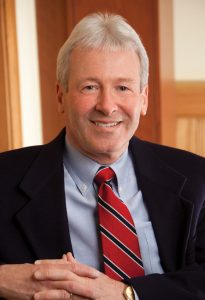By Bill Seymour, Republican-American

NAUGATUCK — In the 50 years since Mark Yanarella started his storied career at the former Naugatuck Savings Bank, customer service then and now remains the cornerstone of banking success, said the longtime local industry leader.
A former chief executive officer and chairman of the board at the bank, Yanarella said that regardless of changes in technology or even banks pushing for more online transactions today, customers must still remain the top priority.
“You have to operate in the best interests of your customer and keep a connection with them,” said Yanarella, reflecting on industry changes as well as constants in the last half-century.
In December, he retired from his position on the board of the bank, which eight years ago changed its name to Ion Bank. He started in 1970 as a management trainee whose first job was working the front line as a teller.
“We were a 100-year-old bank at the time, had 16 employees and had a single building with three executive officers,” he recalled.
“That first job put me in direct contact with customers and would influence me for the rest of my career,” he added.
In time, he moved into bookkeeping, credit, loans and mortgages. They all gave him a firsthand understanding of the bank’s operations that together with service to customers created a mutual dependence.
An economics major and 1970 graduate of Saint Anselm College, Yanarella became senior management’s rising star to watch. Within 10 years he oversaw all lending by the bank and became corporate secretary.
These jobs gave him a front-and-center seat to major changes facing the industry.
“It’s interesting. In 1971, I got an electronic calculator. That was a very big deal back then,” Yanarella said.
As that decade and the next unfolded, he saw the steady deregulation of a strictly supervised industry.
“There was a lot changes and as a result, new skills sets were needed,” Yanarella recalled, accenting emerging technology that included mainframe computers, personal computers, laptops, minicomputers and banking’s interconnecting networks.
“It leveled the playing field,” he said. “It was a very exciting time and a time for growing competitiveness among banks.”
The deregulation brought opportunities, he said, for developing a wide range of services, such as the introduction of automated teller machines or ATMs.
Some have evolved into personal teller machines that give live connections with customer contact center staff. This existing technology helped with customer service when the COVID-19 pandemic reduced person-to-person visits, he said.
For Yanarella, who thrived on managing the bank and employees thrust into change, opportunities developed for him as well over the years.
He was promoted to vice president in 1983 and later elected to both the board of directors and the board of corporators.
He was promoted to executive vice president in 1990. In 1997, he was named president and chief executive officer.
He ultimately became chairman of the board and CEO of the both the bank and Ion Financial Mutual Holding Co.
Expanding the one-time small bank was a focus. It included acquiring Castle Bank of Meriden and Southerland Insurance. In addition, he opened many bank branches throughout the Central Connecticut and Naugatuck Valley region.
As this occurred, a new name to reflect a regional presence was needed. He started discussions leading to the 2013 change in the bank’s name to Ion.
The creation in 1998 of a charitable foundation, now known as the Ion Bank Foundation, is as important as other operational changes, he said.
Since its inception, this charitable foundation has awarded grants totaling over $8.8 million to benefit residents and nonprofit organizations in local communities.
“The bank was almost a religion to us. We considered it a sacred trust,” he said of its mission of helping people and remaining solvent.
Bank officials and staff worked hard to safeguard the trust customers put in them, he said.
“In 2012, when I retired as CEO, people would talk about how I helped them years ago. There was an electrical contractor who thanked me for helping him and that financial assistance from the bank kept his business going,” Yanarella said.
He paused for a moment as a nearly nine-year-old memory came back.
“A lot of people then reminded me of things I had forgotten about that helped them with. It was something big for them,” he said.
“Helping the community — our customers — is what our corporate culture was all about,” he added.













